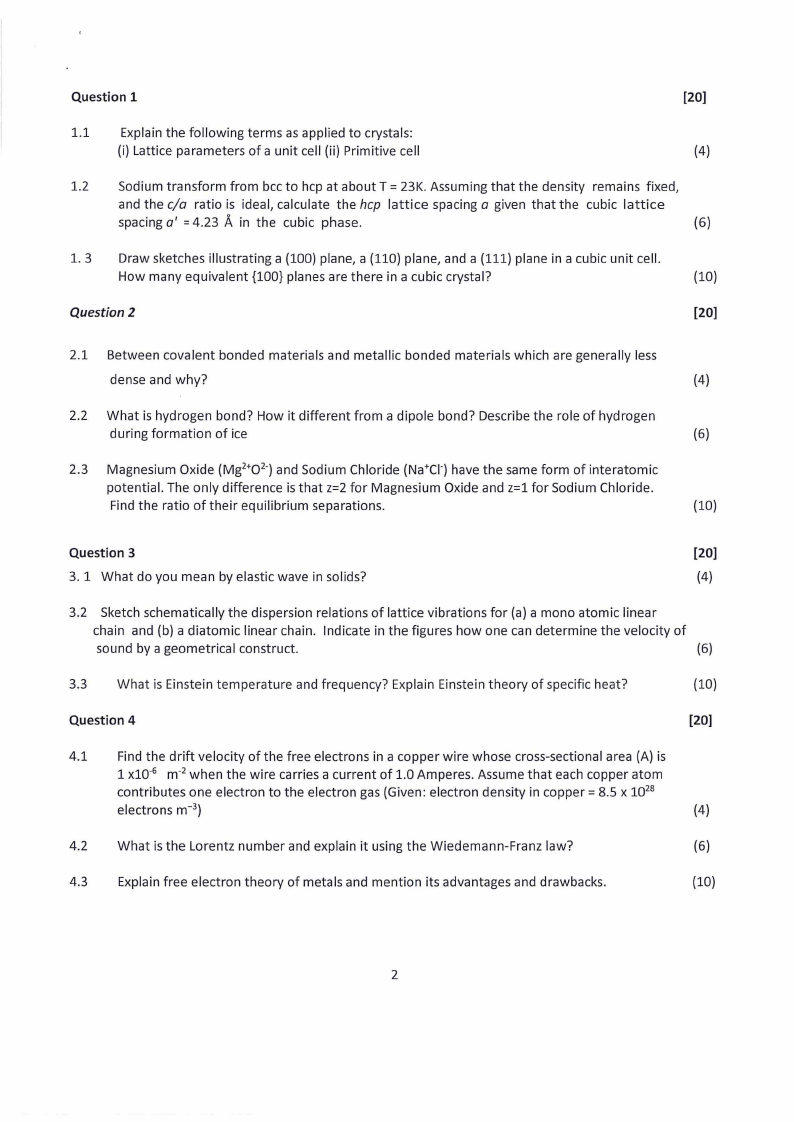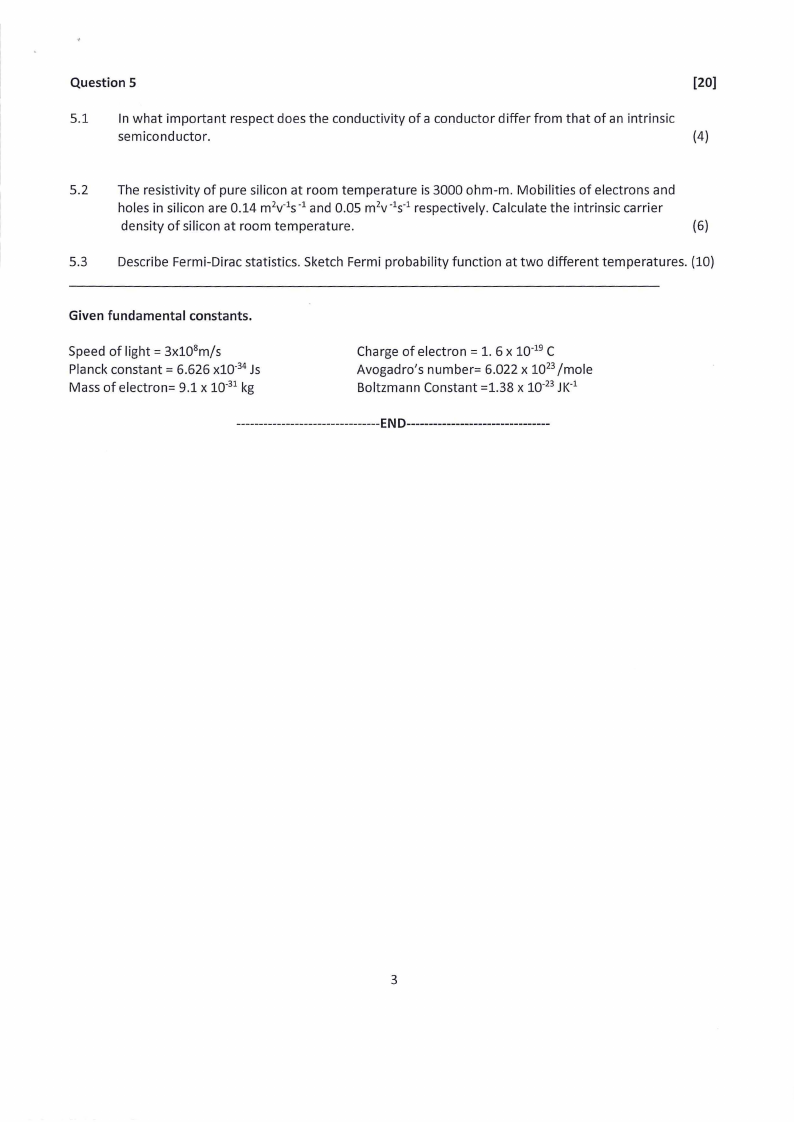 |
SSP701S - SOLID STATE PHYSICS - 2ND OPP - JULY 2023 |
 |
1 Page 1 |
▲back to top |

nAmlBIA unlVERSITY
OF SCIEn CE Ano TECHn OLOGY
FACULTY OF HEALTH, NATURAL RESOURCESAND APPLIED SCIENCES
SCHOOL OF NATURAL AND APPLIED SCIENCES
DEPARTMENT OF BIOLOGY, CHEMISTRY and PHYSICS
QUALIFICATION: BACHELOROF SCIENCE
QUALIFICATION CODE: 07BOSC
COURSE CODE: SSP701S
SESSION: JULY 2023
DURATION: 3 HOURS
LEVEL: 7
COURSE NAME: SOLID STATE PHYSICS
PAPER: THEORY
MARKS: 100
SUPPLEMENTARY/SECOND OPPORTUNITY EXAMINATION QUESTION PAPER
EXAMINER(S)
Prof Dipti Ranjan Sahu
MODERATOR:
Dr Zivayi Chiguvare
INSTRUCTIONS
1. Answer all five questions.
2. Write clearly and neatly.
3. Number the answers clearly.
PERMISSIBLEMATERIALS
Non-programmable Calculators
THIS QUESTION PAPER CONSISTS OF 3 PAGES (Including this front page)
 |
2 Page 2 |
▲back to top |

Question 1
[20]
1.1 Explain the following terms as applied to crystals:
(i) Lattice parameters of a unit cell (ii) Primitive cell
(4)
1.2 Sodium transform from beeto hep at about T = 23K. Assuming that the density remains fixed,
and the c/a ratio is ideal, calculate the hep lattice spacing a given that the cubic lattice
spacing a' = 4.23 A in the cubic phase.
(6)
1. 3 Draw sketches illustrating a (100) plane, a (110) plane, and a (111) plane in a cubic unit cell.
How many equivalent {100} planes are there in a cubic crystal?
(10)
Question 2
[20]
2.1 Between covalent bonded materials and metallic bonded materials which are generally less
dense and why?
(4)
2.2 What is hydrogen bond? How it different from a dipole bond? Describe the role of hydrogen
during formation of ice
(6)
2.3 Magnesium Oxide (Mg2+O2-Jand Sodium Chloride (Na+ci-)have the same form of interatomic
potential. The only difference is that z=2 for Magnesium Oxide and z=l for Sodium Chloride.
Find the ratio of their equilibrium separations.
(10)
Question 3
[20]
3. 1 What do you mean by elastic wave in solids?
(4)
3.2 Sketch schematically the dispersion relations of lattice vibrations for (a) a mono atomic linear
chain and (b) a diatomic linear chain. Indicate in the figures how one can determine the velocity of
sound by a geometrical construct.
(6)
3.3 What is Einstein temperature and frequency? Explain Einstein theory of specific heat?
(10)
Question 4
[20]
4.1 Find the drift velocity of the free electrons in a copper wire whose cross-sectional area (A) is
1 x10-5 m-2 when the wire carries a current of 1.0 Amperes. Assume that each copper atom
contributes one electron to the electron gas (Given: electron density in copper= 8.5 x 1028
electrons m-3)
(4)
4.2 What is the Lorentz number and explain it using the Wiedemann-Franz law?
(6)
4.3 Explain free electron theory of metals and mention its advantages and drawbacks.
(10)
2
 |
3 Page 3 |
▲back to top |

Question 5
[20]
5.1 In what important respect does the conductivity of a conductor differ from that of an intrinsic
semiconductor.
(4)
5.2 The resistivity of pure silicon at room temperature is 3000 ohm-m. Mobilities of electrons and
holes in silicon are 0.14 m2v"1s·1 and 0.05 m2v ·1s·1 respectively. Calculate the intrinsic carrier
density of silicon at room temperature.
(6)
5.3 Describe Fermi-Dirac statistics. Sketch Fermi probability function at two different temperatures. (10)
Given fundamental constants.
Speed of light = 3x108m/s
Planck constant= 6.626 x10·34 Js
Mass of electron= 9.1 x 10-31 kg
Charge of electron = 1. 6 x 10-19 C
Avogadro's number= 6.022 x 1023 /mole
Boltzmann Constant =1.38 x 10-23 JK-1
--------------------------------END------------------------
3





